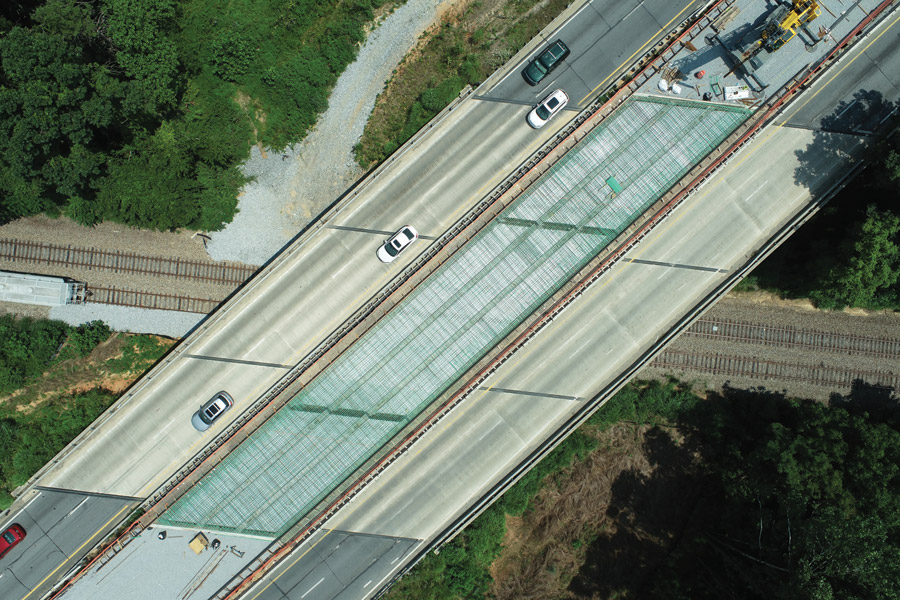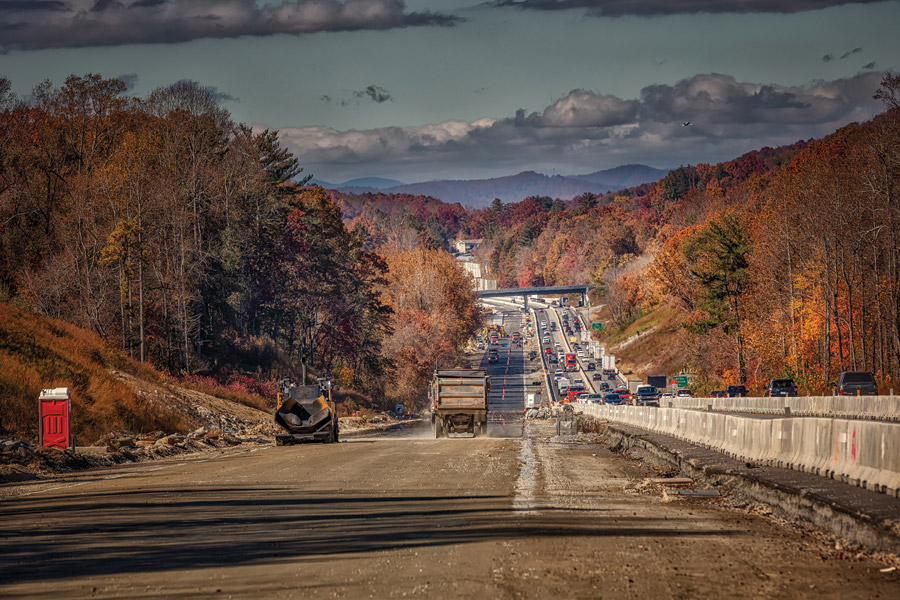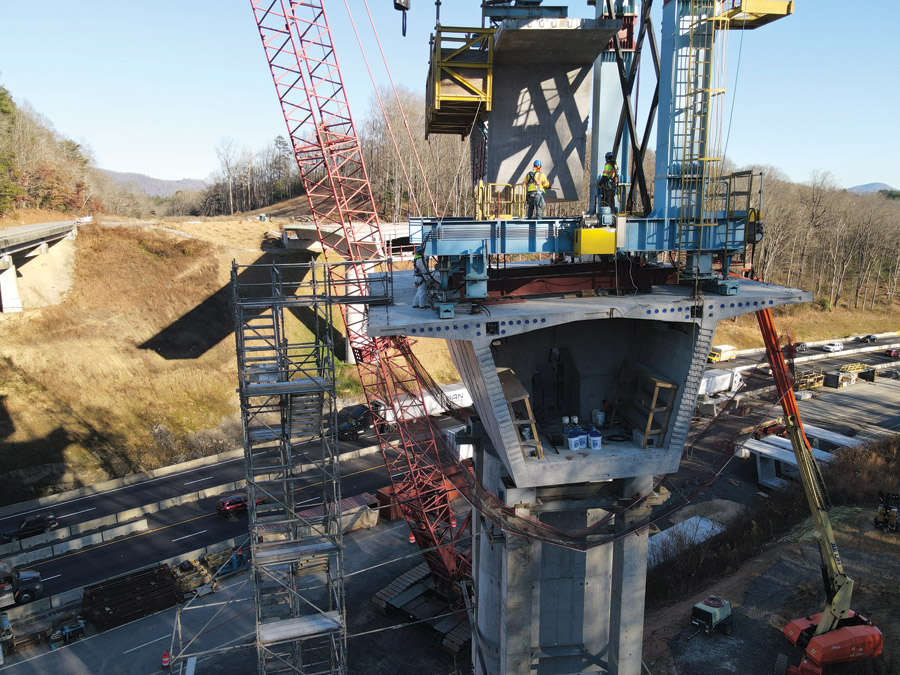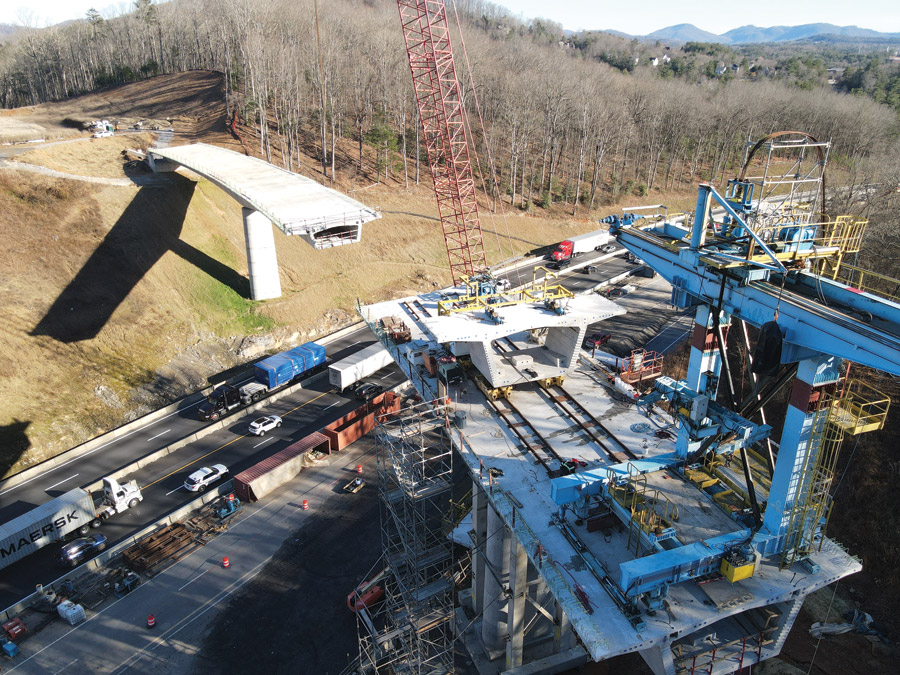According to Mike Patton, resident engineer for North Carolina Department of Transportation (NCDOT) Division 14, which covers the state’s westernmost and hilly counties, it’s harder to widen a road than it is to create one.
The half-billion dollar effort to widen 17 miles of Interstate 26 is one such case. The project, made more complicated by roughly a quarter of a million annual travelers, a global pandemic and a complex interstate bridge, required innovative thinking.

The project is widening 17 miles of Interstate 26 from four lanes to six lanes in Henderson County and eight lanes in Buncombe County.
Photo courtesy of NCDOT
Travel and Destination
The area of I-26 that is being widened is not only filled with drivers heading from the Midwest to the coast, but also with tourists and locals who travel daily. Patton, a nearly 30-year NCDOT veteran, emphasizes the need for the project and its impact, thanks to traffic that includes high levels of trucks and throngs of visitors flocking to Asheville, enough to spend more than $2.8 billion to the city in 2022.
But it’s the local traffic that sets this part of Interstate 26 apart from others in the state like I-95 in eastern North Carolina, says David Uchiyama, NCDOT communications officer for the region.
“That’s the key,” says Patton. “I-26 is really the main artery for a lot of the country to get to the beach or to come visit Asheville.”

NCDOT contracted with a local towing company to quickly respond to any incidents that could slow traffic in the work zone.
Photo courtesy of NCDOT
Traffic counts near Asheville show average daily traffic volumes on I-26 up to 89,000 vehicles per day in 2019, compared to 67,000 in 2002.
The first attempt to ease that burden by widening came more than 20 years ago, but a lawsuit led to a 2003 court ruling that NCDOT had to conduct a broader analysis of environmental impacts, and the project was suspended However, the need did not go away, and in 2013, the project was reinstated in NCDOT’s 10-year State Transportation Improvement Plan. The environmental impact analysis was extended by court order and approved in 2016. In 2019, a joint venture between Fluor and United Infrastructure Group was awarded the $263 million contract for the southern portion of the extension. A joint venture of Archer-Western and Wright Brothers Construction won the remainder of the $531 million project.
“I-26 is really the main artery for a lot of the country to get to the beach or to come visit Asheville.”
—Mike Patton, Division 14 Engineer, NCDOT
The project involves widening both directions of the current four-lane I-26 along nearly 17 miles in Henderson and Buncombe counties to six lanes on the southern portion and eight lanes on the northern portion of the project, closer to Asheville . Work began in October 2019, with completion scheduled for 2024, but the project has since been modified and extended to 2025 to add an entirely new exit near a manufacturing facility of Pratt & Whitney newly built. The details of the additional $37.5 million in works, which will be left as a separate project in the fall, are still being worked out.
Crews began by building a diverging diamond interchange where I-26 meets US 25, another major artery in the area, and upgrading the US 64 interchange, the main Hendersonville exit, to a partial cloverleaf with improved left turns.
Also replaced were two rest areas along the route, at $5 million each, built by the Archer/Wright JV as part of the Henderson County portion of the project. The work is now reaching its final stretch. Earthmoving, paving and structure construction activities are reaching 2024 milestones, including the completion of a bridge over the French Broad River, says Justin Nielson, project manager of the Fluor-United JV. The next milestone is summer 2024, when traffic will be placed in its final pattern along the southernmost section of the Buncombe County portion of the project.

The Blue Ridge Parkway Bridge includes a total of 76 precast concrete segments.
Photo courtesy of NCDOT
Straightening of road cuts
The area’s high traffic volume, more than 58,000 vehicles per day, led to two innovative NCDOT management solutions. The first is the Incident Corridor Management (ICM) system, which synchronizes detour lane traffic lights to speed traffic when the freeway is closed for work or accidents, which are common. The second is a contract established by NCDOT with a local towing company, Carolina Towing, to place equipment near work zones to respond quickly when a disabled vehicle needs to be removed.
It’s the second contract used by NCDOT, a model it now continues to use statewide, Uchiyama says. Response and clearance times are written into the incentivized contract, as are light and heavy towing zones. In this case, Carolina Towing has 20 minutes to be on scene and 20 minutes to clear the highway, with payment based on how quickly the road is cleared.
“The project is still dealing with the after-effects of the pandemic as the supply chain and labor market continue to recover.”
—Justin Nielson, Project Manager, Fluor-United JV
“A wreck on I-26 used to snarl traffic for an hour,” Patton says. “Now their clearance rates are five minutes, as long as there’s no personal damage. So that’s helped a lot.”
Through the end of 2023, the towing company has responded to a total of 3,359 incentives, Uchiyama says. Of these, 2,549 have been light towing or tourism incidents and 810 have been heavy towing or commercial vehicle incentives. Travel times are about the same since construction began and accidents are up about 30%. Both systems have worked well, say Patton and other project leaders. On the night of December 14, both were called into service when a small plane crashed at the work site while attempting to make an emergency landing.
The plane crashed on the freeway and caught fire, injuring the two people on board, damaging the pavement and stopping traffic. The ICM was diverted on the closed part of the freeway while tow trucks were mobilized to clear the roadway; the teams working on the expansion project were mobilized to fix the pavement. Both lanes were reopened by lunchtime the next day.

An on-site crane, used to place the initial sections of the Blue Ridge Parkway bridge, is now only used to unload and place those sections.
Photo courtesy of NCDOT
Nielson didn’t get to name traffic, which affected material delivery times and required non-standard work hours, as the project’s main challenge.
When the pandemic hit shortly after work began, Fluor-United adapted its health and safety protocols in response to changing conditions and regulations, Nielson says, and worked with NCDOT, subcontractors and suppliers to overcome the ‘extension of delivery periods. NCDOT’s statewide consideration of material price escalations for contracts awarded prior to March 2022 proved helpful.
“While the day-to-day impacts are not as frequent, the project is still dealing with the after-effects of the pandemic as the supply chain and labor market continue to recover,” says Nielson.
“Everything now costs four times what it cost a year ago,” adds Patton. “You can try to plan ahead for a lot of the things we face, but…it’s hard to plan.”
Precast concrete for items like wall panels and drain boxes has caused more headaches for his team, including a period of cement shortages, but supply chain issues have come up for basically all materials at some point of the project, he says. As the project gained momentum, the team adjusted its procurement planning to the new reality, allowing for longer lead times to ensure materials arrive when they are needed, or stocking them on site if possible. if they arrive earlier.

Due to limited space and steep banks, a segment lift is being used to lift and place precast bridge sections for the Blue Ridge Parkway Bridge over the interstate.
Photo courtesy of NCDOT
Complicated crossing
The complicated logistics and phased construction schedule of the $14.5 million Blue Ridge Parkway bridge over the freeway are the project’s main challenges for Nielson, with limited space and steep banks requiring immediate consideration.
NCDOT overcame these limitations using a precast segmental bridge design, only the second in the state’s network, says Luke Middleton, RK&K resident engineer. VSL, a certified segmental bridge contractor working worldwide, was hired to manage the project.
The 469-mile highway has for years ranked among the National Park Service’s most visited sites, with nearly 16 million visitors expected by 2022. The new two-lane bridge, 605 feet long and 36 feet ‘wide over I-26 also carries a sidewalk and the nearly 1,200-mile Mountains-to-Sea Trail that runs from the Outer Banks to the Smoky Mountains. The expansion plans required a replacement bridge, as the bridge piers had to be removed. The new bridge, which is being built using the balanced cantilever method, is planned to span the freeway without piers between the traffic lanes.
Standing between 80 and 100 feet tall, the new highway bridge is an imposing sight for I-26 drivers coming up from the south.
Middleton says the bridge will require a total of 76 precast concrete segments, curving at 6% over its entire length. Fourteen of those segments are for docks, he adds, with one dock higher than the other.
It took 18 months to cast the entire bridge in Wilmington, North Carolina, where NCDOT stationed personnel at the casting yard to ensure specifications were met, with each segment of the bridge rated at 6,000 psi or higher. The National Park Service and Federal Highway Administration are working to make infrastructure like this last longer to make the funds stretch longer, Middleton says. Crews are using a crane to unload and handle the bridge sections, then place the initial segments until there is enough bridge surface for the segment lifter, Nielson explains.
“This bridge has been impressive to watch go up,” says Middleton.

